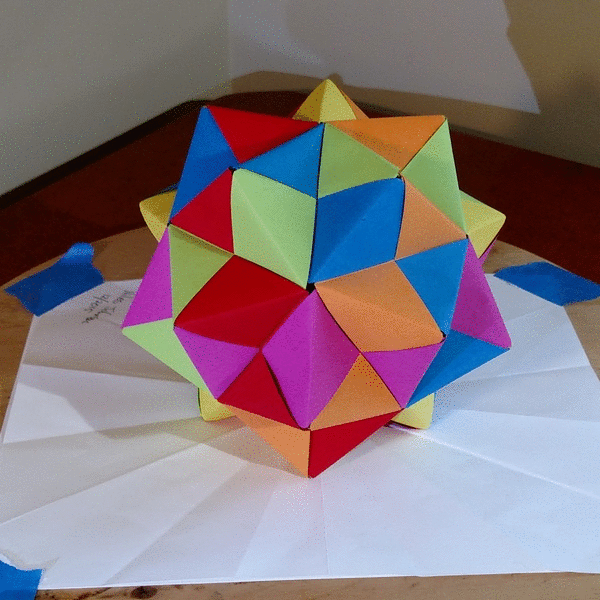Stellated Icosahedron
A stellated icosahedron made with 30 Sonobe modules in 6 colors. The colors are arranged in 6 interlocking bands, with 5 distinct colors meeting at each of 12 star-shaped faces. There are 20 triangular points in 10 antipodal pairs. These each have 3 colors, and the 10 pairs represent all possible choices of 3 colors.

Click here for the interactive spinner (javascript)
Instructions
![[color scheme thumbnail]](/images/sticosa-color-thumb.jpg)
Instructions for folding and assembling the 30 Sonobe units can be found at either of the links below. For this color scheme, use 6 colors, and fold 5 units in each color.
The map above gives instructions for how to arrange the colors while assembling the units. Here's how to read it:
- The key to understanding this map is to realize that each unit corresponds to an edge of the icosahedron. As they're assembled, each unit lends some color to each of two different "spikes" on the icosahedron -- the two which meet along the edge formed by that unit. And each spike has color from three different units -- the three units forming the three edges around the base of the spike.
- To best understand how these edges are laid out, draw a sketch of the icosahedron as in the picture below. (My mom drew that one!) Its 20 faces can be arranged as a group of 5 on the "top half", another group of 5 on the "bottom half", and 10 more around the "middle". Of these 10, 5 are adjacent to the "top half", 5 are adjacent to the "bottom half", and they fit together like gear teeth along the middle.
- For fun, take a moment to count the vertices, edges, and faces. The arithmetic shown in the picture below computes the Euler characteristic of this shape. Amazingly, it always comes out to be 2 for anything that is topologically a sphere (the surface of a ball in 3 dimensions, that is).
- You can make the top/bottom split using the 5 faces around any particular vertex. Since there are 12 vertices, this gives 6 top/bottom pairs, and 6 "middles" -- thes are the 6 bands of color you see in the model!
- Label your drawing as in the map above (or below). Each group of 5 edges emmanating from a single vertex has 5 colors, leaving out 1 -- this missing color makes a band around the "middle".
- Looking at the 5 edges emmanating from a vertex, or the 5 edges forming a pentagon around that vertex, note that the same 5 colors appear, in the same clockwise order (just rotated a little). The sixth color appears along the "middle", on half of the edges (alternating as you go around). The other half of the middle edges are the other 5 colors, in the same clockwise order you previously noted. The other half has the same colors, but now in counterclockwise order. This is because the same coloring appears on opposite faces over the entire shape.
- As you label and read your map, use "driving directions" to keep yourself from getting disoriented. That is, organize your thinking around what kinds of turns you would make while traveling along the edges.
- Good luck and enjoy!
![[color scheme notes]](/images/sticosa-color-notes.jpg)
tags: papercraft | mathart
![[klein quartic]](/images/papercraft/kleinquart/IMG_20151230_101013953.jpg)
![[stellated dodecahedron]](/images/papercraft/dodecast/IMG_20180111_104426115.jpg)
![[five tetrahedra]](/images/papercraft/tetra5/IMG_20180111_105239139.jpg)